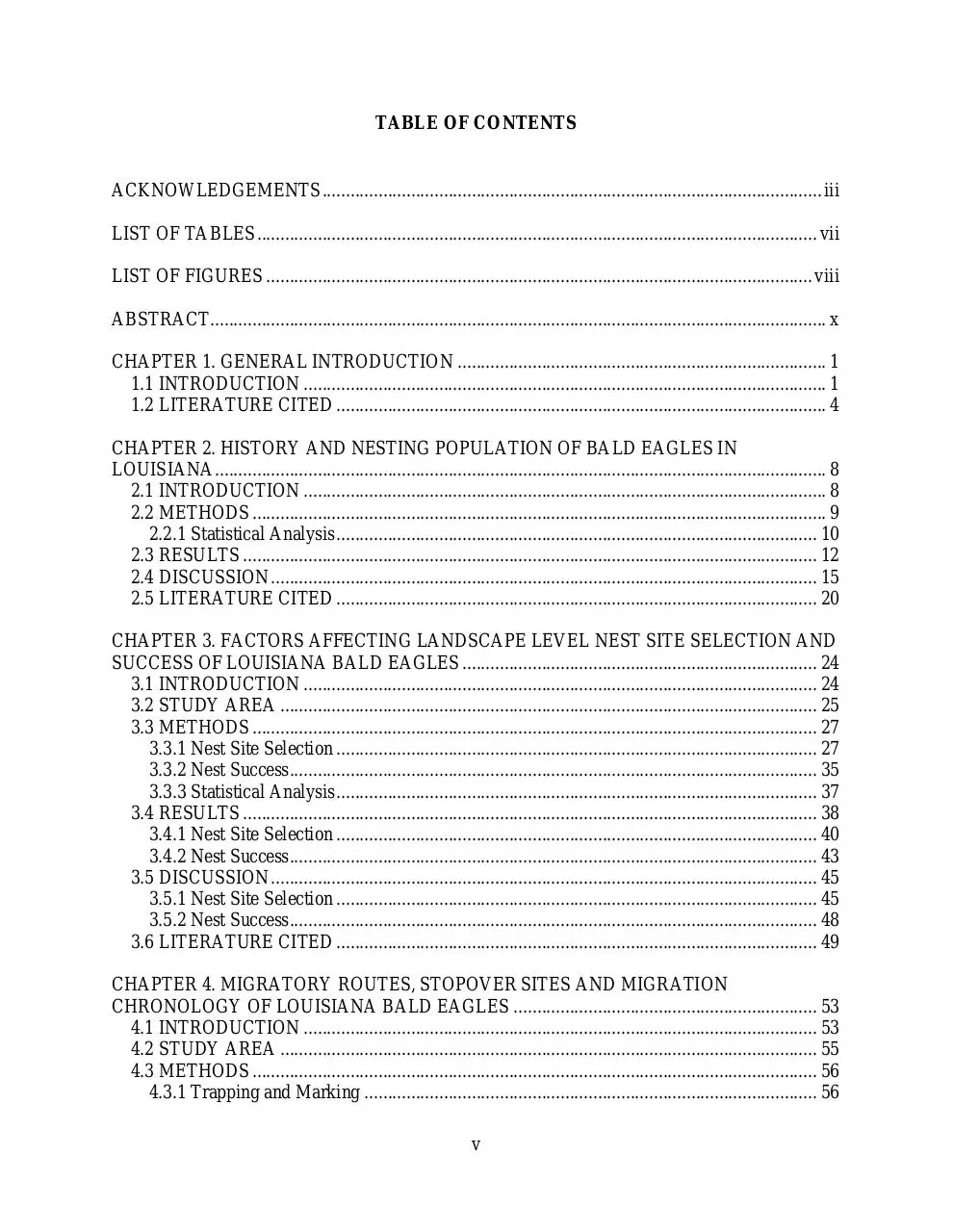Smith Thesis (PDF)
File information
Author: Nickolas R Smith
This PDF 1.5 document has been generated by Microsoft® Word 2010, and has been sent on pdf-archive.com on 11/04/2017 at 02:02, from IP address 75.64.x.x.
The current document download page has been viewed 554 times.
File size: 5.08 MB (133 pages).
Privacy: public file





File preview
HISTORY, NESTING POPULATION, MIGRATION, HOME RANGE AND
HABITATS USED BY LOUISIANA BALD EAGLES
A Thesis
Submitted to the Graduate Faculty of the
Louisiana State University and
Agricultural and Mechanical College
in partial fulfillment of the
requirements for the degree of
Master of Science
in
The School of Renewable Natural Resources
by
Nickolas R. Smith
B.S., South Dakota State University, 2008
August 2014
This work is dedicated to the memory of Thomas Hess, who devoted much of his career
to the Bald Eagles of Louisiana. His dedication and hard work have been a big influence on my
life and was a major factor in making this research possible. His life exemplified the meaning of
pursuing your dreams and living your passion. That passion he had for wildlife and Louisiana
touched so many lives and will live on in future generations of wildlife biologists and outdoor
enthusiasts to come.
ii
ACKNOWLEDGEMENTS
First, I would like to thank all my family and friends, especially my parents, Bob and
Jeanie Smith. Their love, encouragement, and support has allowed me to turn my passions into a
career and helped mold me into the person I am today. I thank my major professor, Dr. Alan
Afton, and my committee members, Drs. David Blouin and Lei Wang for all their advice and
assistance.
I greatly appreciate the financial support provided by the Louisiana Department of
Wildlife and Fisheries and the U.S. Fish and Wildlife Service, Division of Federal Aid, through
Louisiana State Wildlife Grant T-98, the Rockefeller Wildlife Refuge Trust, the U.S. Geological
Survey-Louisiana Cooperative Fish and Wildlife Research Unit, and the School of Renewable
Natural Resources at Louisiana State University. I thank the U.S. Fish and Wildlife Service at
Mandalay National Wildlife Refuge for providing lodging during field operations and especially
Paul Yakupzack for his encouragement and guidance. I also thank the many landowners who
provided local knowledge and access to their property. I thank Louisiana State University
Wildlife Hospital and especially Drs. Joao Brandao and Javier Navarez for assistance and
cooperation in collecting morphometrics and blood samples from Bald Eagles admitted to the
hospital.
I want to acknowledge the work of Ray Aycock, Wayne Debuc, Thomas Hess
(deceased), Jeb Linscombe, George Melancon, and all the individuals from U.S. Fish and
Wildlife Service and Louisiana Department of Wildlife and Fisheries who assisted with
Louisiana’s nest monitoring program since 1975. I want to acknowledge all those who assisted
with trapping: Bruce Davis, Micheal Drury, John Harrelson, Dr. James LaCour, Eric Ledet,
Matthew McCollister, Justin Rabalais, Jason Stelzer, and Sara Zimorski. I especially thank my
iii
field technician Sarah Norton for her invaluable assistance with catching, handling, and marking
of birds. I also greatly appreciate all of the training provided by Paul Link and his help with
trapping and the rocket-net system; his expertise was truly reflective of the trapping success that
was experienced.
I thank all those who aided in searching for marked birds that died: Brian Clark, Sarah
Hamilton, Alonda McCarty, Winston Michel, Annika Olsen, Dave Olsen, and Roy Pier. I thank
David Douglas from U.S. Geological Survey-Alaska Science Center for his assistance with
satellite telemetry data. I thank Thomas Hess (deceased), Will Selman, and the rest of the staff at
Rockefeller Wildlife Refuge for their critical help and guidance on my project. I thank Brett
Mandernack and Scott Mehus for taking the time to talk with me about their experiences
catching and marking eagles. I also thank Drs. Michael Kaller and Kevin McCarter for all their
statistical advice. Finally, I am ever grateful to Alonda McCarty for all her assistance and
encouragement.
iv
TABLE OF CONTENTS
ACKNOWLEDGEMENTS ........................................................................................................... iii
LIST OF TABLES ........................................................................................................................ vii
LIST OF FIGURES ..................................................................................................................... viii
ABSTRACT .................................................................................................................................... x
CHAPTER 1. GENERAL INTRODUCTION ............................................................................... 1
1.1 INTRODUCTION ................................................................................................................ 1
1.2 LITERATURE CITED ......................................................................................................... 4
CHAPTER 2. HISTORY AND NESTING POPULATION OF BALD EAGLES IN
LOUISIANA ................................................................................................................................... 8
2.1 INTRODUCTION ................................................................................................................ 8
2.2 METHODS ........................................................................................................................... 9
2.2.1 Statistical Analysis ....................................................................................................... 10
2.3 RESULTS ........................................................................................................................... 12
2.4 DISCUSSION ..................................................................................................................... 15
2.5 LITERATURE CITED ....................................................................................................... 20
CHAPTER 3. FACTORS AFFECTING LANDSCAPE LEVEL NEST SITE SELECTION AND
SUCCESS OF LOUISIANA BALD EAGLES ............................................................................ 24
3.1 INTRODUCTION .............................................................................................................. 24
3.2 STUDY AREA ................................................................................................................... 25
3.3 METHODS ......................................................................................................................... 27
3.3.1 Nest Site Selection ....................................................................................................... 27
3.3.2 Nest Success ................................................................................................................. 35
3.3.3 Statistical Analysis ....................................................................................................... 37
3.4 RESULTS ........................................................................................................................... 38
3.4.1 Nest Site Selection ....................................................................................................... 40
3.4.2 Nest Success ................................................................................................................. 43
3.5 DISCUSSION ..................................................................................................................... 45
3.5.1 Nest Site Selection ....................................................................................................... 45
3.5.2 Nest Success ................................................................................................................. 48
3.6 LITERATURE CITED ....................................................................................................... 49
CHAPTER 4. MIGRATORY ROUTES, STOPOVER SITES AND MIGRATION
CHRONOLOGY OF LOUISIANA BALD EAGLES ................................................................. 53
4.1 INTRODUCTION .............................................................................................................. 53
4.2 STUDY AREA ................................................................................................................... 55
4.3 METHODS ......................................................................................................................... 56
4.3.1 Trapping and Marking ................................................................................................. 56
v
4.3.2 Migration ...................................................................................................................... 57
4.3.3 Statistical Analysis ....................................................................................................... 58
4.4 RESULTS ........................................................................................................................... 58
4.4.1 Trapping and Marking ................................................................................................. 58
4.4.2 Migration ...................................................................................................................... 59
4.5 DISCUSSION ..................................................................................................................... 64
4.5.1 Trapping and Marking ................................................................................................. 64
4.5.2 Migration ...................................................................................................................... 65
4.6 LITERATURE CITED ....................................................................................................... 69
CHAPTER 5. WINTER AND SUMMER HOME RANGES OF LOUISIANA BALD EAGLES
....................................................................................................................................................... 74
5.1 INTRODUCTION .............................................................................................................. 74
5.2 STUDY AREA ................................................................................................................... 76
5.3 METHODS ......................................................................................................................... 76
5.3.1 Trapping and Marking ................................................................................................. 76
5.3.2 Home Range................................................................................................................. 78
5.3.3 Statistical Analysis ....................................................................................................... 79
5.4 RESULTS ........................................................................................................................... 79
5.5 DISCUSSION ..................................................................................................................... 83
5.6 LITERATURE CITED ....................................................................................................... 86
CHAPTER 6. MORPHOMETRIC SEX DETERMINATION OF BALD EAGLES FROM
LOUISIANA ................................................................................................................................. 90
6.1 INTRODUCTION .............................................................................................................. 90
6.2 METHODS ......................................................................................................................... 91
6.2.1 Statistical Analysis ....................................................................................................... 92
6.3 RESULTS ........................................................................................................................... 92
6.4 DISCUSSION ..................................................................................................................... 94
6.5 LITERATURE CITED ....................................................................................................... 95
CHAPTER 7. CONCLUSIONS ................................................................................................... 97
APPENDIX A. NATIONAL LAND COVER DATABASE CLASSIFICATION
DESCRIPTIONS ........................................................................................................................ 101
APPENDIX B. PHOTOS OF ROCKET-NET SYSTEM .......................................................... 103
APPENDIX C. MIGRATION PARAMETERS ......................................................................... 105
APPENDIX D. MIGRATION MAPS ........................................................................................ 106
APPENDIX E. WINTER AND SUMMER HOME RANGE MAPS ........................................ 116
APPENDIX F. MORPHOMETRIC MEASUREMENTS .......................................................... 121
VITA ........................................................................................................................................... 122
vi
LIST OF TABLES
Table 2.1. Summary of Bald Eagle nesting in Louisiana from 1975–2008. .................................13
Table 3.1. Summary of data used to model landscape level nest site selection and success. .......28
Table 3.2. Logistic regression models predicting Louisiana Bald Eagle nest sites (n = 387)
versus random sites (n = 387), including number of parameters (K), Akaike’s
Information Criterion adjusted for small sample size (AICc), difference between
the AICc of the given model and the model with the lowest AICc (ΔAICC), and
Akaike’s model weight (wi). ........................................................................................41
Table 3.3. Parameter estimates, standard error (SE), lower 85% confidence limits (LCL), and
upper 85% confidence limits (UCL) for the top model from 18 a priori candidate
models used to examine nest site selection of Louisiana Bald Eagles. Variables
with 85% confidence limits that do not overlap zero are considered significant and
are depicted in bold. .....................................................................................................42
Table 3.4. Logistic regression models predicting successful Louisiana Bald Eagle nest sites
(n = 266) versus unsuccessful sites (n = 49), including number of parameters (K),
Akaike’s Information Criterion adjusted for small sample size (AICc), difference
between the AICc of the given model and the model with the lowest AICc
(ΔAICC), and Akaike’s model weight (wi). .................................................................44
Table 4.1. Deployment dates, age, sex, and PTT number for 11 Bald Eagles marked in 2012
and 2013. ......................................................................................................................59
Table 5.1. Individual winter and summer home ranges, core areas, and percent overlap of
first year home ranges for radio-marked Louisiana Bald Eagles. A 95% and 50%
Brownian bridge movement model were used to estimate home range and core
area size in square kilometers. .....................................................................................81
Table 5.2. Mean size of winter and summer home ranges ( ±SE in km2) of radio-marked
Louisiana Bald Eagles as calculated using 95% Brownian bridge movement
models and displayed as ±SE in square kilometers. .................................................82
Table 6.1. Comparison of sex and age class variation in beak depth and hallux claw length.
All measurements are in mm. ......................................................................................93
vii
LIST OF FIGURES
Figure 2.1. Numbers of known active nests, successful nests and total young produced by
Louisiana Bald Eagles from 1975–2008 with fitted exponential models weighted by
sample size (Active Nests = e(0.111*Year – 217.41), Successful Nests = e(0.098*Year – 190.85),
Total Young Produced = e(0.114*Year – 222.10) ). ............................................................. 12
Figure 2.2. Numbers of known active nests by parish in Louisiana in 1975 and 2008. .............. 14
Figure 2.3. Nest success, productivity, and brood size of Louisiana Bald Eagles from 1975–2008
with best fitted models weighted by number of active nests (solid lines) and 95%
confidence intervals (dashed lines). Brood size was best represented by the intercept
only model (weighted mean = 1.63 ±0.02). .............................................................. 15
Figure 3.1. Land cover map of Louisiana showing six geographic ecoregions. .......................... 26
Figure 3.2. Map of Louisiana Bald Eagle nests sites from winter 2007-2008 (n = 387) with
corresponding random sites (n = 387) stratified by ecoregion and restricted to
suitable habitat. .......................................................................................................... 29
Figure 3.3. Plot of distance to historical nest centroid x distance to nearest road with inset map
depicting distribution of nests within Louisiana. ...................................................... 32
Figure 3.4. Plot of percent forest, percent agricultural, and percent emergent herbaceous wetland
within 3 km of a nest site x distance to historical nest centroid (km) depicting
interaction between land cover types and distance to historical nest centroid. ......... 34
Figure 3.5. Distribution of distances from a nest to the next nearest nest. .................................. 39
Figure 3.6. Distribution of distances from a nest to the nearest open water. ............................... 39
Figure 3.7. Percent of 6 land cover types within 3 km of random sites, known active nests, and
successful and unsuccessful nests of Louisiana Bald Eagles from winter 2007-2008.
................................................................................................................................... 40
Figure 3.8. Percent of area within each ecoregion that was comprised of suitable habitat (<1 km
from open water and in forest, woody wetland, or emergent herbaceous wetland
within 1 km from another forest or woody wetland land cover type). ...................... 43
Figure 4.1. Eighty km radius trapping area (red polygon) centered on Mandalay NWR
headquarters and winter 2007-2008 Bald Eagle nest locations (black dots). ............ 55
viii
Figure 4.2. Timeline of mean departure/arrival dates for north and southbound migrations,
depicting average duration of north (blue) and southbound migrations (red) as well
as time spent on summering areas (green) for adult and sub-adult Bald Eagles
tracked with satellite telemetry from Louisiana in 2012–2013. ................................ 60
Figure 4.3. Migration routes, stopover sites, and summering areas of 9 Bald Eagles tracked by
satellite telemetry from Louisiana in 2012. Note Bald Eagle 208 died on its
summering area in the Northwest Territories of Canada. ......................................... 62
Figure 4.4. Migration routes, stopover sites, and summering areas of 9 Bald Eagles tracked by
satellite telemetry from Louisiana in 2013. Note this is the first depicted movements
for Bald Eagle 207. .................................................................................................... 63
Figure 5.1. Eighty km radius trapping area (red polygon) centered on Mandalay NWR
headquarters and winter 2007-2008 Bald Eagle nest locations (black dots). ............ 76
Figure 5.2. Utilization distribution of 2012 winter home ranges for a nesting adult Bald Eagle
200 (red) and a non-nesting sub-adult Bald Eagle 204 (blue) created using Brownian
bridge movement models and depicted in 3D. .......................................................... 82
Figure 6.1. Sexual size variation between males (black squares) and females (diamonds) in
relation to beak depth (mm) and hallux length (mm). Shaded diamonds represent
females that were misclassified as males using the Bortolotti (1984b) method. The
lines illustrate the discrimination boundaries which separate males from females
using the Bortolotti (1984b) formula (dashed) and my formula based on Louisiana
Bald Eagles (solid). ................................................................................................... 93
ix
Download Smith Thesis
Smith_Thesis.pdf (PDF, 5.08 MB)
Download PDF
Share this file on social networks
Link to this page
Permanent link
Use the permanent link to the download page to share your document on Facebook, Twitter, LinkedIn, or directly with a contact by e-Mail, Messenger, Whatsapp, Line..
Short link
Use the short link to share your document on Twitter or by text message (SMS)
HTML Code
Copy the following HTML code to share your document on a Website or Blog
QR Code to this page

This file has been shared publicly by a user of PDF Archive.
Document ID: 0000580714.